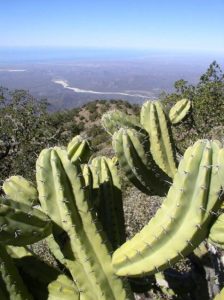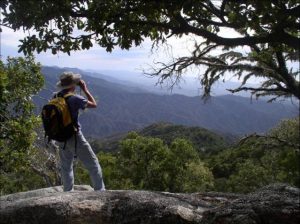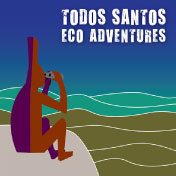by Sergio and Bryan Jáuregui, Todos Santos Eco Adventures (this article was first published in Janice Kinne’s Journal del Pacifico)
The Baja peninsula has long been famous for its remote and beautiful islands, most of which we are accustomed to visiting via water craft. But there is an island near Todos Santos that is readily accessible by car that we can easily explore on foot: the Sierra de la Laguna Biosphere Reserve. Part of an island off the coast of Baja some 10 million years ago, the incredible diversity of plant and animal life of the Reserve still reflects the island isolation the area once enjoyed – over 23% of plants and 10% of animals found in the Reserve are endemic to the area. Nestled between Todos Santos to the west and Los Barriles to the east, La Paz to the north and Los Cabos to the south, it is truly an island of lushness surrounded by shores of desert and sand.
Biosphere Reserves in Mexico
The Sierra de la Laguna Biosphere Reserve was created by presidential decree in 1994 by Carlos Salina de Gortari. To be designated a biosphere reserve in Mexico a place must meet 3 basic criteria:

Photo by Craig Ligibel
- Have an endemic or threatened species. And we’ve got that in spades! The Sierra de la Laguna Biosphere Reserve boasts an astounding 79 endemic plant species, 8 endemic reptile species, 4 endemic bird species and 4 endemic mammal species. A total of 59 species of birds, 40 species of mammals, 31 species of reptiles and 61 species of insects have been recorded in the Reserve. Over 900 species of plants have been observed. It’s truly extraordinary.
- Cover an area greater than 10,000 hectares. There’s plenty of room to spread out! The Biosphere Reserve covers 11,600 glorious hectares (~28,665 acres), while the Sierra de la Laguna area itself, including the Biosphere Reserve, encompasses 112,436 hectares (roughly 277,835 acres).
- Have one ecosystem that is not substantially altered by human contact. The Sierra de la Laguna is one of Baja’s most beautiful but least explored areas, with plenty of wild spots that have largely escaped the impact of human civilization. In addition to animals such as mountain lions, mule deer, gophers and badgers, a wonderful array of birdlife inhabits the reserve, including the endemic cape pygmy owl, Xantus hummingbird and Belding´s yellowthroat, making the area a bird-lover’s paradise.
Biosphere reserves in Mexico are created with three main objectives in mind: conservation, training and sustainable human development compatible with conservation. Unlike national parks, biosphere reserves allow people to continue to live in the protected areas – although new population centers are prohibited – and our reserve has 35 private properties and 6 ejidos. That result is that the Sierra de la Laguna retains a thriving ranchero culture that is great fun to explore.
Hiking the Sierra de la Laguna
There are a variety of ways to explore and enjoy the Sierras on foot and in all these hikes the diversity of terrain is amazing. At the base is San Lucan Xeric Scrub, also known as Mezquital, which merges with the dry forest. These areas feature a large number of plants that have adapted well to life with limited water including palo zorillo (skunk trees), torotes (elephant trees), lomboy trees and ironwood. The dry forest extends up to about 800 meters (~2,600 feet) and is remarkable in the juxtaposition of plant life, with mosses and other plants that thrive on water co-habiting with more arid types like cardon and biznaga. If you’re still hiking at this point you’ll experience the wonder of moving up through an unexpected oak forest in Baja then on into lush preserves of pine and oak from about 1,400 meters (~4,600 feet). It’s a remarkable transformation of terrain.

Photo by Craig Ligibel
If you’ve made it this far chances are you’ll be camping in the high valley and at this point you may start to ask yourself, “If this is the Sierra de la Laguna, i.e., Mountains of the Lagoon, where the heck is the lagoon?” Well, there was indeed once a lagoon in the flat meadow between the highest peaks but that drained away around 1870 after years of supporting local agricultural and mining operations, leaving only the name behind. But that doesn’t mean that there isn’t water in the Sierras. Indeed in normal, non-drought years the Sierras can receive over 100 centimeters (39 inches) of rain and serve as a key water source for Todos Santos, Pescadero and other coastal communities. If you have a few nights to camp you should take a day to explore the beautiful waterfalls near the high valley created by this relative abundance of rain.
And of course, if you’ve come all this way you must take a day to explore El Picacho, the incredible 2,161 meters (~7,000 foot) peak from which you can enjoy sweeping panoramic views of the peninsula, with the Sea of Cortez on one side and the Pacific Ocean on the other. If you’re lucky enough to make it up to El Picacho you’ll see clearly that the Sierra de la Laguna Biosphere Reserve is not only a literal island now rooted firmly in a landmass, but also a magical, magnificent island of the sky.
In the Know – Mauricio Duran, Head Guide with Todos Santos Eco Adventures. On the geographic scale the Sierras are mere youngsters, clocking in at about 138 million years old. By comparison, parts of the Appalachian Mountains in the U.S. are 650 million years old, while the Barberton Greenstone Belt in eastern Africa has mountains that are 3.5 billion years old, widely believed to be the earth’s oldest.
Hiking with Todos Santos Eco Adventures
We offer several different options for hiking and exploring the incredible beauty and diversity of the Sierra de la Laguna Biosphere Reserve:
Day Hikes: We have 2 day hike options in the Sierras. One is called Reaching for the Sky and, as the name implies, we climb as far as we can before we have to turn around to make it home before dark. The other is the Riverbed Stroll, which is generally flat and easy and in which we encounter waterfalls at certain times of the year. There is magnificent flora on both hikes and excellent birding.
Overnight Hikes: We offer two 4-day/3-night hikes and a 2-day/1-night hike. The 4-day hikes include Sea-to-Sea in which we start at the Pacific Ocean, hike across the peninsula through the Biosphere Reserve, and end at the Sea of Cortez. The other 4-day hike is the Todos Santos Loop. The main difference is that the latter features an easier descent and less exciting logistics. On both 4-day hikes there are burros to carry all the gear, guides to lead the way, cooks to prepare the food and pour the wine, and warm sun showers to wash away the exertions of each day. Decidedly comfortable camping! The 4-day hikes are only for avid walkers. The 2-day/1-night hike is a terrific combination of Reaching for the Sky and Riverbed Stroll. All hikes are lead by experienced guides and naturalists who are certified Wilderness First Responders. www.tosea.net
